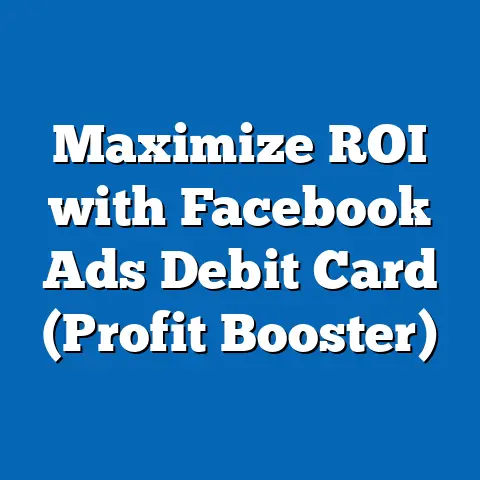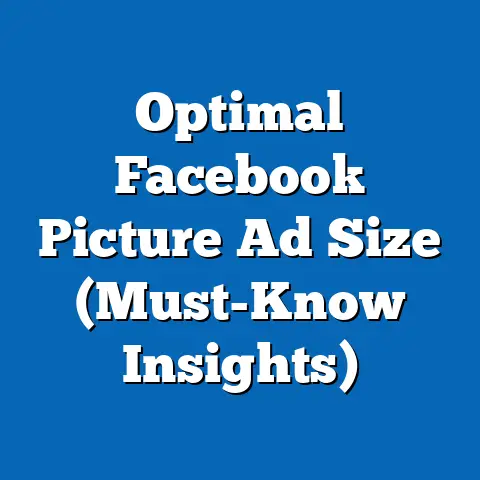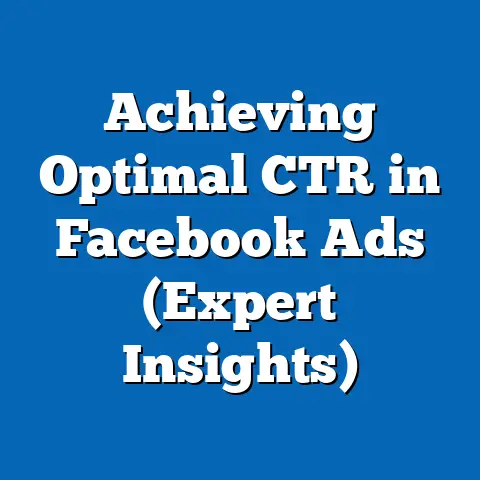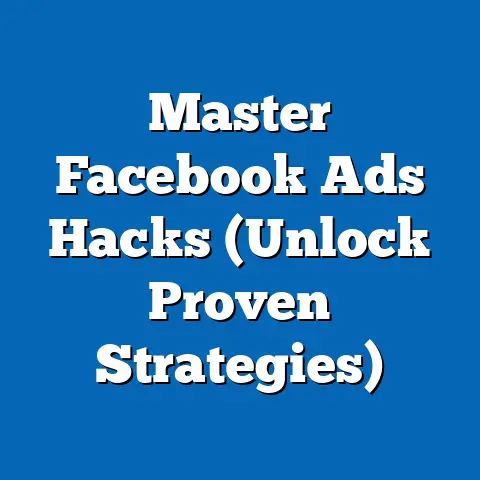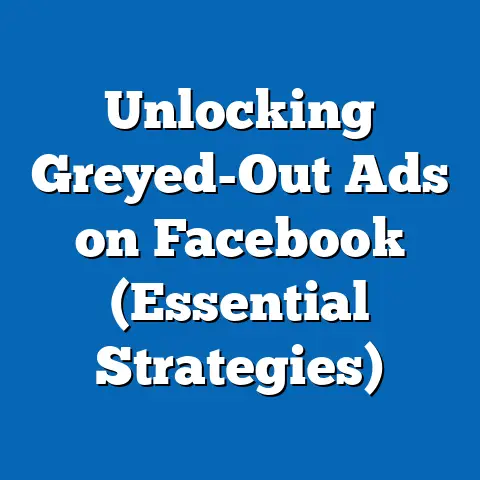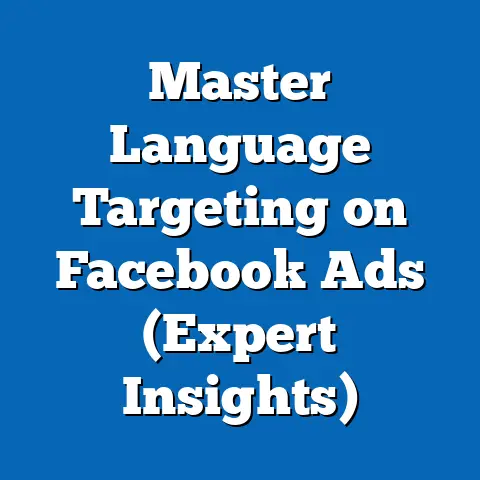Discover Facebook Ads Effortlessly (Pro Strategies Inside)
In a realm where complexity often reigns supreme, mastering Facebook Ads can seem both daunting and deceptively simple. I’ve seen firsthand how businesses, both big and small, struggle to navigate the intricacies of the platform, often feeling overwhelmed by the sheer volume of options and data. On the one hand, setting up a basic ad is relatively straightforward; on the other hand, achieving consistent, profitable results requires a deeper understanding and a strategic approach.
Facebook Ads, now part of the Meta advertising ecosystem, are undeniably crucial for modern marketing. They offer unparalleled reach, granular targeting capabilities, and a diverse range of ad formats to suit virtually any business goal. But with this power comes complexity. Many marketers believe that Facebook Ads require advanced skills, extensive knowledge, and a near-constant monitoring to be effective.
However, I’m here to tell you that it doesn’t have to be that way. With the right strategies, anyone can navigate Facebook Ads effortlessly and effectively. This guide will break down the key elements, from understanding the basics to implementing pro-level tactics, so you can unlock the true potential of Facebook advertising for your business. My goal is to empower you to confidently create and manage campaigns that drive real results.
Understanding the Basics of Facebook Ads
Facebook Ads are paid messages that businesses use to reach their target audience on Facebook and Instagram (and, to a lesser extent, the Audience Network). Their importance in driving traffic and conversions cannot be overstated. In fact, Facebook remains a dominant force in digital advertising, reaching billions of active users worldwide.
Here’s why Facebook Ads are so powerful:
- Massive Reach: Facebook has over 2.9 billion monthly active users, providing an enormous potential audience for your ads.
- Precise Targeting: Facebook’s detailed targeting options allow you to reach specific demographics, interests, behaviors, and even custom audiences based on your own customer data.
- Diverse Ad Formats: From simple image ads to engaging video ads and interactive experiences, Facebook offers a variety of ad formats to capture attention and convey your message.
- Measurable Results: Facebook’s robust analytics provide detailed insights into your ad performance, allowing you to track key metrics and optimize your campaigns for maximum ROI.
Let’s quickly go over some of the common ad formats:
- Image Ads: Single image ads are simple, clean, and effective for showcasing products or services with a compelling visual.
- Video Ads: Video ads are highly engaging and can be used to tell stories, demonstrate products, or share testimonials.
- Carousel Ads: Carousel ads allow you to display multiple images or videos in a single ad, perfect for showcasing different products or features.
- Collection Ads: Collection ads are designed for e-commerce businesses, allowing users to browse and purchase products directly from the ad.
- Lead Ads: Lead ads make it easy for people to sign up for newsletters, request quotes, or download resources without leaving Facebook.
To manage these ads, you’ll use Facebook Ads Manager, the central hub for creating, managing, and analyzing your campaigns. The key components you’ll encounter are:
- Campaigns: These are the overarching containers for your advertising efforts, where you define your objective (e.g., traffic, leads, sales).
- Ad Sets: Within each campaign, you create ad sets to define your target audience, budget, schedule, and placement (where your ads will appear).
- Ads: These are the individual creative pieces that users will see, including your ad copy, visuals, and call-to-action.
I remember when I first started using Ads Manager, the interface felt overwhelming. There were so many buttons and options, I didn’t know where to start! But once I understood the basic structure of campaigns, ad sets, and ads, it became much more manageable. Don’t be intimidated – just take it one step at a time.
Takeaway: Facebook Ads are a powerful tool for reaching a vast audience and driving conversions. Familiarize yourself with the different ad formats and the Ads Manager interface to start building your campaigns.
Identifying Your Target Audience
The success of any Facebook ad campaign hinges on your ability to reach the right people. Targeting the wrong audience is like shouting into the void – you’ll waste your budget and get little to no results. That’s why audience targeting is paramount in Facebook advertising.
Facebook offers a wealth of targeting options to help you narrow down your audience and reach the people most likely to be interested in your products or services. These include:
- Demographic Targeting: Target users based on age, gender, location, education, job title, and other demographic factors.
- Interest-Based Targeting: Reach people who have expressed interest in specific topics, hobbies, or brands on Facebook.
- Behavior Targeting: Target users based on their online behavior, such as purchase history, device usage, and travel habits.
- Custom Audiences: Create custom audiences based on your own customer data, such as email lists, website visitors, or app users.
- Lookalike Audiences: Expand your reach by targeting people who are similar to your existing customers or website visitors.
To create effective targeting, it’s essential to develop buyer personas, detailed profiles of your ideal customers. These personas should include information about their demographics, interests, pain points, and motivations.
For example, let’s say you’re selling organic skincare products. Your ideal customer might be a woman aged 25-45, interested in natural beauty, wellness, and sustainable living. She might be a frequent shopper at organic grocery stores and follow eco-conscious influencers on social media.
Facebook also provides a very useful Audience Insights tool that you can use to refine your targeting. This tool allows you to analyze the demographics, interests, and behaviors of people who are connected to your Facebook page or who are part of your custom audiences. You can use this information to identify new targeting opportunities and optimize your existing campaigns.
I once worked with a client who was struggling to generate leads for their business coaching services. After conducting thorough audience research and creating detailed buyer personas, we discovered that their ideal clients were entrepreneurs and small business owners with a strong interest in personal development and leadership. By refining our targeting based on these insights, we were able to significantly increase the number of qualified leads generated from their Facebook ad campaigns.
Takeaway: Effective audience targeting is crucial for Facebook ad success. Develop detailed buyer personas, utilize Facebook’s targeting options, and leverage the Audience Insights tool to reach the right people with your ads.
Crafting Compelling Ad Copy and Creative
Once you’ve identified your target audience, the next step is to create compelling ad copy and creative that captures their attention and motivates them to take action. This is where the art of persuasive writing and visual storytelling comes into play.
Ad Copy: Your ad copy should be clear, concise, and relevant to your target audience. It should highlight the benefits of your product or service and address their pain points. Key elements of effective ad copy include:
- Headlines: Your headline is the first thing people will see, so make it count. Use strong verbs, numbers, and questions to grab attention.
- Body Text: Your body text should expand on your headline and provide more details about your offer. Focus on the benefits, not just the features.
- Calls-to-Action (CTAs): Your CTA should tell people exactly what you want them to do, such as “Shop Now,” “Learn More,” or “Sign Up.”
Visuals: Your visuals (images or videos) should be high-quality, visually appealing, and relevant to your ad copy. They should capture attention and convey your message effectively. Consider these tips:
- Use High-Quality Images: Avoid blurry or pixelated images.
- Choose Relevant Visuals: Make sure your visuals are relevant to your product or service and your target audience.
- Use Eye-Catching Colors: Use colors that stand out and grab attention.
- Test Different Visuals: Experiment with different images and videos to see what performs best.
Here are a couple of examples of high-performing ad copy and visual elements:
Example 1: E-commerce Ad
- Headline: “50% Off All Summer Dresses – Limited Time Only!”
- Body Text: “Stay cool and stylish this summer with our collection of organic cotton dresses. Shop now and get 50% off your entire order!”
- CTA: “Shop Now”
- Visual: A high-quality image of a model wearing a stylish summer dress.
Example 2: Lead Generation Ad
- Headline: “Free Guide: 5 Steps to Grow Your Business Online”
- Body Text: “Download our free guide and learn how to attract more customers, generate more leads, and grow your business online.”
- CTA: “Download Now”
- Visual: A visually appealing graphic of the guide cover.
I remember when I was first starting out, I used to spend hours crafting the perfect ad copy, only to see it fall flat. It wasn’t until I started focusing on the benefits and addressing the pain points of my target audience that my ads really started to perform. Also, don’t underestimate the power of testing. Try different headlines, body text, visuals, and CTAs to see what resonates best with your audience.
Takeaway: Crafting compelling ad copy and creative is essential for capturing attention and driving conversions. Focus on the benefits, address pain points, and use high-quality visuals to create ads that resonate with your target audience.
Setting a Budget and Bidding Strategy
Setting the right budget and bidding strategy is crucial for maximizing your ROI on Facebook Ads. It’s about finding the sweet spot where you’re spending enough to reach your target audience but not overspending and wasting your budget.
Facebook offers two main budget types:
- Daily Budget: Set a fixed amount that you’re willing to spend each day.
- Lifetime Budget: Set a total amount that you’re willing to spend over the entire duration of your campaign.
The right budget type depends on your goals and how much control you want over your spending. If you want to ensure that you’re spending consistently each day, a daily budget is a good choice. If you want to have more flexibility and let Facebook optimize your spending over the entire campaign duration, a lifetime budget might be better.
Facebook also offers various bidding strategies to control how much you’re willing to pay for each click, impression, or conversion. Common bidding strategies include:
- Cost-Per-Click (CPC): You pay each time someone clicks on your ad.
- Cost-Per-Impression (CPM): You pay for every 1,000 impressions (times your ad is shown).
- Cost-Per-Action (CPA): You pay only when someone takes a specific action, such as making a purchase or filling out a form.
The best bidding strategy depends on your campaign objective and your target audience. If you’re focused on driving traffic to your website, CPC bidding might be a good choice. If you’re focused on brand awareness, CPM bidding might be better. If you’re focused on generating conversions, CPA bidding might be the most cost-effective option.
Here are a few tips for optimizing your budgets and bids:
- Start Small: Begin with a smaller budget and gradually increase it as you see results.
- Monitor Your Performance: Keep a close eye on your ad performance and adjust your bids accordingly.
- Use Automatic Bidding: Facebook’s automatic bidding algorithms can help you optimize your bids for maximum ROI.
- Test Different Bidding Strategies: Experiment with different bidding strategies to see what performs best for your campaigns.
I’ve learned that it’s better to start with a smaller budget and gradually increase it as you see results. This allows you to test different targeting options, ad copy, and visuals without risking a large amount of money. Also, don’t be afraid to experiment with different bidding strategies. What works for one campaign might not work for another.
Takeaway: Setting the right budget and bidding strategy is essential for maximizing your ROI on Facebook Ads. Start small, monitor your performance, and experiment with different options to find what works best for your campaigns.
Analyzing Performance Metrics
Analyzing your performance metrics is crucial for understanding how your Facebook ad campaigns are performing and identifying areas for improvement. Without data, you’re simply guessing.
Key performance indicators (KPIs) that you should be tracking include:
- Click-Through Rate (CTR): The percentage of people who see your ad and click on it. A high CTR indicates that your ad copy and visuals are resonating with your target audience.
- Conversion Rate: The percentage of people who click on your ad and complete a desired action, such as making a purchase or filling out a form. A high conversion rate indicates that your landing page is effective and your offer is compelling.
- Cost-Per-Click (CPC): The average cost you pay for each click on your ad. A low CPC indicates that your targeting is effective and your ads are relevant to your target audience.
- Cost-Per-Conversion (CPA): The average cost you pay for each conversion. A low CPA indicates that your campaigns are efficient and your ROI is high.
- Return on Ad Spend (ROAS): The amount of revenue you generate for every dollar you spend on advertising. A high ROAS indicates that your campaigns are profitable and you’re getting a good return on your investment.
Interpreting these metrics is crucial for understanding the story your data is telling. For example, a high CTR but a low conversion rate might suggest that your ad copy and visuals are effective, but your landing page needs improvement. A high CPC but a low CPA might suggest that your targeting is too broad and you need to narrow it down.
A/B testing is a powerful technique for continuously improving your ad performance. It involves creating two versions of an ad (A and B) with slight variations and then testing them against each other to see which one performs better. You can A/B test different headlines, body text, visuals, CTAs, and targeting options.
I once worked with a client who was struggling to improve their conversion rate on their Facebook ad campaigns. After implementing A/B testing, we discovered that changing the headline from “Shop Now” to “Get 20% Off” significantly increased their conversion rate. Small changes can often have a big impact.
Takeaway: Analyzing your performance metrics and implementing A/B testing are crucial for continuously improving your Facebook ad campaigns. Track key KPIs, interpret the data, and experiment with different options to see what performs best.
Pro Strategies for Success
Now that you have a solid understanding of the basics, let’s dive into some pro strategies that can take your Facebook ad campaigns to the next level.
- Retargeting: Retargeting involves showing ads to people who have previously interacted with your website or app. This is a highly effective strategy because these people are already familiar with your brand and are more likely to convert.
- Lookalike Audiences: Lookalike audiences allow you to expand your reach by targeting people who are similar to your existing customers or website visitors. This is a great way to find new customers who are likely to be interested in your products or services.
- Dynamic Ads: Dynamic ads automatically show the most relevant products to each user based on their browsing history and interests. This is a powerful strategy for e-commerce businesses looking to increase sales.
Integrating Facebook Ads with other marketing channels can create a more holistic and effective marketing strategy. For example, you can use Facebook Ads to drive traffic to your website, where you can capture leads through email marketing. You can also use Facebook Ads to promote your content marketing efforts and drive engagement on your social media channels.
Finally, staying updated with Facebook’s advertising policies and algorithm changes is crucial for maintaining compliance and maximizing your ad performance. Facebook is constantly updating its policies and algorithms, so it’s important to stay informed and adapt your strategies accordingly.
I’ve found that retargeting is one of the most effective strategies for driving conversions. By showing ads to people who have already visited your website, you’re reminding them of your brand and encouraging them to take action. Also, I highly recommend integrating Facebook Ads with your other marketing channels. This creates a more cohesive and effective marketing strategy.
Takeaway: Implement pro strategies such as retargeting, lookalike audiences, and dynamic ads to take your Facebook ad campaigns to the next level. Integrate Facebook Ads with your other marketing channels and stay updated with Facebook’s advertising policies and algorithm changes.
Conclusion
In conclusion, while Facebook Ads can seem complex at first glance, mastering them is entirely achievable with the right strategies and a willingness to learn and adapt. We’ve explored the fundamental elements, from understanding the basics of the platform to crafting compelling ad copy and creative, setting budgets, analyzing performance metrics, and implementing pro-level tactics.
By embracing a data-driven approach, continuously testing and optimizing your campaigns, and staying informed about the latest trends and best practices, you can unlock the true potential of Facebook Ads for your business. Don’t be intimidated by the complexity – take action, apply the strategies shared in this guide, and discover the power of Facebook Ads to drive traffic, generate leads, and grow your business. The world of Facebook advertising is at your fingertips – now go out there and make it your own!

